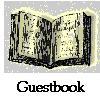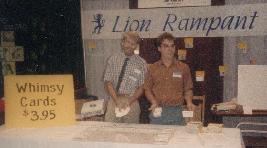







 |
 |
 |
 |
 |
 |
 |
 |
||
 |
|||||||
|
Games: |
|||||||
|
Here's some of the major gaming stuff I've done over the years. In 1987, Mark Rein•Hagen and I founded Lion Rampant to publish RPGs. Whimsy Cards (1987, Lion Rampant publisher): Thematic cards that players use to affect the plot of an RPG session. They never made us money, but they gave us something to sell at our GenCon booth, since Ars Magica was behind schedule. I doubt you can find these cards anywhere. Ars Magica (1987, Lion Rampant): Designed this RPG with Mark Rein•Hagen. It's about wizards in a mythic version of the Middle Ages, with a remarkable magic system and a ton of good roleplaying content. If you want to see where the core system for the current edition of D&D comes from, pick up Ars Magica. The current edition of Ars Magica is published by Atlas Games. (Wikipedia entry) Order of Hermes (1989, Lion Rampant): A defining supplement for Ars Magica, covering the houses (lineages) of the wizards. Copied repeatedly in other games, this book is itself a copy of Cults of Prax. The Stormrider (1989, Lion Rampant): A quick-start adventure for first-time Ars Magica GMs. It had pregenerated characters and rules summaries for the players, plus step-by-step instructions written into the adventure for the GM. It prefigured the work I'd do later on beginner games, especially the D&D Adventure and Basic games. In 1989, I left Lion Rampant, and in 1990 I started free lancing. Over the Edge (1992, Atlas Games): The roleplaying game that I tried to talk John Nephew out of publishing. Free-form, postmodern roleplaying on an island of nightmare and insanity. With inimitable elements provided by Robin D. Laws. Still published by Atlas Games, the only game on which I still get royalties. Please buy a copy. (Wikipedia entry) In 1993, Wizards hired me to run RPGs. I'd already been free lancing for them. Rivals of Esthedil (never, Wziards of the Coast): Wizards hired me as a free lancer to write this big campaign for The Primal Order, and I killed it once they hired me to run RPGs (1993). I mention it because Amazon lists it, and a couple of folks have asked me about it. It set the players up as would-be conquerors of a small plane. On the Edge (1994, Atlas Games): Designed this TCG with John Nephw. Aliens meet modern sorcerers meet Wotanic street gangs in all out war for covert domination. Not the best TCG ever created, but one of the best (considering how terrible so many of them have been). Still played in Finland. Talislanta Guidebook (1994, Wizards of the Coast): An overhaul of Stephen Michael Sechi's excellent Talislanta RPG and setting. I was originally commissioned to write an introductory adventure, but I convinced Wizards that there was no introductory adventure to write until the system itself had been fixed. Apocalypse (1994, Mayfair Games): How to blow up your campaign. This big, boxed project was part of Mayfair's semi-licit, pseudo-d20 products. Everway (1995, Wizards of the Coast): I call this the "girlfriend game" because so many male gamers have told me that it's the only RPG that their girlfriends or wives want to play. No dice, just a tarot-like deck (the Fortune Deck) and infinite possibilities. New Age fantasy. It sold to all the gamers with girlfriends and was promptly cancelled for low revenue. Theoretically still available from Gaslight Press, perhaps easier to find on eBay. In 1995, Wizards cut its RPGs and I started working on TCGs. Portal (1997, Wizards of the Coast): Magic: the Gathering for beginners, teaching the rules with a programmed, paint-by-numbers first game. Dungeons & Dragons, 3rd Edition (2000, Wizards of the Coast): My good friend Peter Adkison installed me as lead designer of this plum project. Rewriting D&D has allowed me to run the D&D campaign that I'd always wanted. Dungeons & Dragons Adventure Game (2000, Wizards): Super simple introduction to D&D, combining my experience with beginner games and D&D design. "Dungeon of the Fire Opal" (DUNGEON Magazine #84): Half-random, all dungeon crawl. Available in a back issue from Paizo. "Wedding Bells" (DUNGEON Magazine #89): A town-based, roleplaying-oriented D&D adventure. For folks who like D&D and wonder whether I still do anything more character- or story-oriented, like I used to. Available in a back issue from Paizo. Chainmail (2001, Wizards of the Coast): Skirmish combat for D&D, the reason that skeletons and zombies got turned into templates. Not related to the original Chainmail with its essentialist fantasy combat system. It's this work on miniatures systems that led me to end up as the design manager for miniatures games. Omega World (2002, Polyhedron Magazine/DUNGEON Magazine #94): Big mutant action after the bomb, my homage to Gamma World. It was a joy to write this game, since the d20 system made it easy to handle to various weirdnesses that mutations bring to a game. Available in a back issue from Paizo. "Death from Above" [Critical Threat] (2003, DUNGEON Magazine #100): How to nuke the PCs in your D&D campaign, like I did. This is an invisible, flying, fireballing wizard, and if the PCs in your campaign haven't faced someone like this yet, you're missing out. Available in a back issue from Paizo. Dungeons & Dragons Miniatures (2003, Wizards):This was our chance to revisit "D&D miniatures skirmish" and undo all the mistakes we'd made with Chainmail. For a while I was the miniatures design manager in R&D, and I did design and development work on various DDM sets.Strangely, I still haven't gotten my D&D characters made into miniatures, though the halfling in my Elysombra campaign appears as a mini. "Ruins of Fear and Madness" (Wizards web site): This is a random dungeon, using the random dungeon rules from the Miniatures Handbook. This pdf includes images for statue cards that you can print, cut out, and slip into card sleeves. It also has 6 pre-gen characters from the Miniatures Handbook: catfolk, stonechild, healer, marshall, favored soul, and warmage. I ran this dungeon at Ropecon. Download it free. Dungeons & Dragons Basic Game (2004, Wizards): Another introduction to D&D, this time with painted miniatures instead of punch-out tokens. Star Wars Miniatures (2004, Wizards): This was a chance to work with the basic system from DDM but simplify it in several places. I worked on system design and served as design manager. Hecatomb (2005, Wizards): Creepy TCG with see-through, five-sided cards. I was on the system design team and I led the world design team. Axis & Allies Miniatures (2005, Wizards): World War II battles with collectable tanks, artillery, and soldiers. I was on the design team and served as R&D lead while the project got off the ground. Dreamblade Collectable Miniatures Game (2006, Wizards): A different kind of miniatures game. —JoT
|
|||||||
|
Mark Rein•Hagen and I selling Whimsy Cards at GenCon 1987 |
|||||||